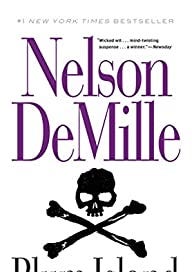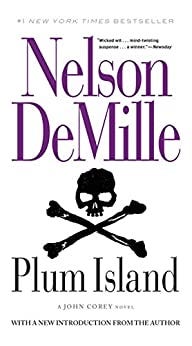Welcome to Chapter 1, where I break down the first chapter of mysteries and thrillers to figure out how they hook us—or why they fail to. If you'd like me to tackle the first chapter of your novel or WIP, just reply to this email and let me know.
The book
Plum Island by Nelson DeMille
First line
Through my binoculars, I could see this nice forty-something-foot cabin cruiser anchored a few hundred yards offshore.
What happens?
New York City homicide detective John Corey is convalescing in rural eastern Long Island after getting shot in the line of duty. Sylvester Maxwell, chief of the Southold Town Police Department, arrives and tells Corey that two locals were just found murdered. Corey knew them: Tom and Judy Gordon.
Maxwell asks Corey to consult on the case. Corey agrees. As they drive out to view the crime scene Corey asks if Maxwell has informed the Feds. Because Tom and Judy were biologists who worked at the top secret biological research site on nearby Plum Island.
Chapter breakdown
I have a love-hate relationship with Nelson DeMille. He writes some of the best crime novels I’ve ever read, so long as you ignore his endings, which tend to be infuriatingly anti-climactic. But, hey, this isn’t Last Chapter, this is Chapter 1, and here we get DeMille in all his glory.
It’s a great chance for us to delve into every writer’s favorite topic (cue sarcasm): voice.
This chapter, this book, this series, is oozing with voice. Corey is so entertaining it’s worth going on a 600 page journey with him even though you know it’s going to leave you unsatisfied in the end.
It may be helpful, in this regard, to quote a bit from DeMille’s Forward to Plum Island, where he talks about the origin of his lead character:
When I first created John Corey in 1997, there was a wave of something new called political correctness sweeping the country, and people, including writers, were shying away from the old stereotypes, the macho cop, the guy who told sexist and ethnic jokes, swore, drank hard liquor, and smoked.
So, in a contrary moment, I decided to create a character who was decidedly un-PC, and who had some real issues with the world of feelings and sensitivity. The only adjustment Corey makes to the modern world is that he doesn’t smoke, and you shouldn’t either.
So Corey is intended to push people’s buttons. But he’s not an ass. He is, as DeMille explains:
a man who is a lovable rogue, a guy who says what’s on his mind, takes care of business, and is as smart as he is tough, and as complex as he is simple.
He leaves out Corey’s most important characteristic—the thing that makes him a lovable rogue instead of just a rogue: humor. If you had to single out one tool that makes Corey so irresistible it’s that he’s funny as hell.
We’re not talking stand up comedian funny (though there are several laugh out loud moments throughout the series). We’re talking “guy telling you a story at a bar” funny. Which, by the way, if you wanted to summarize DeMille’s voice in this novel, would do just fine. The book is written as if it were being told to you at the Yard House over a pint of ale.
Here's how DeMille starts:
Through my binoculars, I could see this nice forty-something-foot cabin cruiser anchored a few hundred yards offshore. There were two thirtyish couples aboard, having a merry old time, sunbathing, banging down brews and whatever. The women had on teensy-weensey little bottoms and no tops, and one of the guys was standing on the bow, and he slipped off his trunks and stood there a minute hanging hog, then jumped in the bay and swam around the boat. What a great country. I put down my binoculars and popped a Budweiser.
It was late summer, not meaning late August, but meaning September, before the autumnal equinox. Labor Day weekend had gone, and Indian summer was coming, whatever that is.
I, John Corey by name, convalescing cop by profession, was sitting on my uncle’s back porch, deep in a wicker chair with shallow thoughts running through my mind. It occurred to me that the problem with doing nothing is not knowing when you’re finished.
The reason we feel like we’re being told the story directly is the informality. “…forty-something-foot” “thirtyish” “…and whatever.” Contrast that with Lee Child’s Jack Reacher. Reacher is precise:
I was riding the subway, in New York City. The 6 train, the Lexington Avenue local, heading uptown, two o’clock in the morning. I had gotten on at Bleecker Street from the south end of the platform into a car that was empty except for five people. Subway cars feel small and intimate when they’re full. When they’re empty they feel vast and cavernous and lonely. At night their lights feel hotter and brighter, even though they’re the same lights they use in the day. They’re all the lights there are. I was sprawled on a two-person bench north of the end doors on the track side of the car. The other five passengers were all south of me on the long bench seats, in profile, side on, far from each other, staring blankly across the width of the car, three on the left and two on the right.
As I noted when I discussed Reacher, this precision is consistent with his character. Child is precise because Reacher is precise. He’s on guard, taking in all the details, constantly ready for danger.
The result is a totally different voice from Corey. Whereas Reacher is a throwback to the strong silent type, Corey is more the wisecracking hero.
Another tool used to maintain the informality is tangents followed by abrupt transitions that return us to the main train of thought. The kind of thing that happens in oral storytelling. Example.
I looked out the open side window. We were driving along the main east-west road, which is conveniently called Main Road, toward a place called Nassau Point where the Gordons live—or lived.
Quick interjection. That’s another tool to inject informality: qualifying yourself mid-speech. And this qualification happens to be super-realistic. When you find out someone you knew has died, it takes time to start speaking of them in the past tense. Continuing.
The North Fork is sort of like Cape Cod, a windswept jut of land surrounded on three sides by water and covered with history.
The full-time population is a little thin, about twenty thousand folks, but there are a lot of summer and weekend types, and the new wineries have attracted day-trippers. Put up a winery and you get ten thousand wine-sipping yuppie slime from the nearest urban center. Never fails.
Anyway, we turned south onto Nassau Point. . . .
It’s almost stream of consciousness. We start with Corey looking out the window. His thoughts naturally go to details about the place he’s driving through, and once he’s thinking about the place then he’s thinking about the people in the place, and once he’s thinking about the people in the place who come for the wineries, then he starts thinking about the wineries…then he realizes he’s dropped the main thread and comes back to it with the “Anyway.” (“Anyway” is Corey’s go-to transition. I think he uses it four times in eight pages.)
So that’s the basic combination that makes up Corey’s voice: informal, stream-of-consciousness writing mixed with regular doses of humor, all channeled through the wise-cracking, macho cop archetype.
Now, you can’t exactly engineer voice. I’m talking about some of the more obvious tools DeMille uses to give Corey his distinctive voice, but a hundred other writers could write a wise-cracking detective who talks stream of consciousness and they’d come up with a hundred different voices. Your voice will be a combination of your conscious tactics—and your unique writing style.
Voice, mainly, is discovered, not constructed. But the more you can articulate what makes a strong voice strong, the more you’ll be able to channel your unique writing style into a distinctive voice for your character.
But back to the humor. I said that DeMille leans heavily on humor to get us to fall in love with Corey. But what makes Corey funny?
Bits and pieces
I’m a huge fan of comedy, but I don’t have a worked out theory of comedy. But here’s the conventional wisdom on humor, and it’ll do for our purposes:
Some scholars have devoted some time to considering how humor works, and have developed theories explaining it. Perhaps the most supported and useful is known as incongruity theory, which asserts that humor “results from the experience of incongruity and its appreciation or resolution.” For example, stand-alone jokes work because they simultaneously evoke two seemingly unrelated systems of expectation. The “punch line” bridges these systems to resolve the incongruity. We experience pleasure in making an unexpected connection within this resolution. Such a connection has been likened to the feeling associated with solving a puzzle, and to cognitive “play.” Incongruity and its appreciation exist in comments, quips, puns, and other behaviors, not only stand-alone jokes. Sarcastic comments contain incongruity between what is spoken and what is intended. Violations of social norms are incongruous in expected, versus actual, behaviors.
Let’s see if this helps us make sense of Corey’s humor. Take that first paragraph I quoted earlier:
Through my binoculars, I could see this nice forty-something-foot cabin cruiser anchored a few hundred yards offshore. There were two thirtyish couples aboard, having a merry old time, sunbathing, banging down brews and whatever. The women had on teensy-weensey little bottoms and no tops, and one of the guys was standing on the bow, and he slipped off his trunks and stood there a minute hanging hog, then jumped in the bay and swam around the boat. What a great country.
The incongruity is between the tawdry scene and the celebratory patriotism of the last line.
Here’s another example. Corey is listening to music on his front porch:
Somewhere in the two seconds of silence between “When a Man Loves a Woman” and “Dancing in the Street,” I could hear or feel on the creaky old floorboards that someone was walking around the porch. Since I live alone and was expecting no one, I took the .38 in my right hand and rested it on my lap. So you don’t think I’m a paranoid citizen, I should mention that I was convalescing, not from the mumps, but from three bullet wounds, two 9mm and one .44 caliber Magnum, not that the size of the holes matters. As with real estate, what matters with bullet holes is location, location, location. Obviously, these holes were in the right locations, because I was convalescing, not decomposing.
Part of what makes this funny is the incongruity between the whimsical way he’s talking and the subject he’s talking about. And then there’s the unexpected connection between a common real estate slogan and Corey’s lesson about bullet wounds. That punchline gets followed up by what amounts to an added punchline: the contrast between convalescing and decomposing.
Look, I get it. Nothing is less funny than analyzing humor. But I did want to highlight this idea that you can inject incongruity to make your writing funnier, more lively, and more rewarding to read.
Lessons learned
Readers love a character with a strong voice.
A voice is a combination of your writing style and your POV character’s unique ways of thinking and talking.
Reward readers with humor by seeking out incongruity.
Please don’t write books with shitty endings.
Verdict: Hooked or cooked?
Hooked (so long as I ignore that the ending will probably suck)
Until next time,
D.P.
P.S. Enjoy this breakdown? Be sure to share it. And don't forget to check out the reviews of my thriller, I AM JUSTICE. Yes, it’s really that good.





